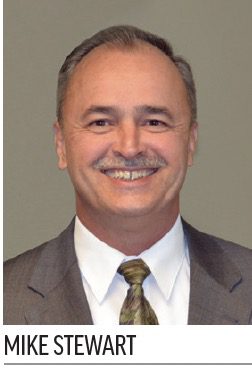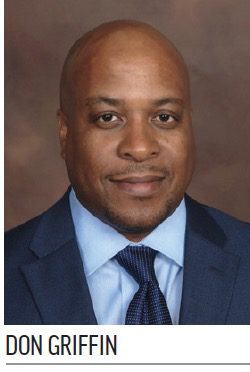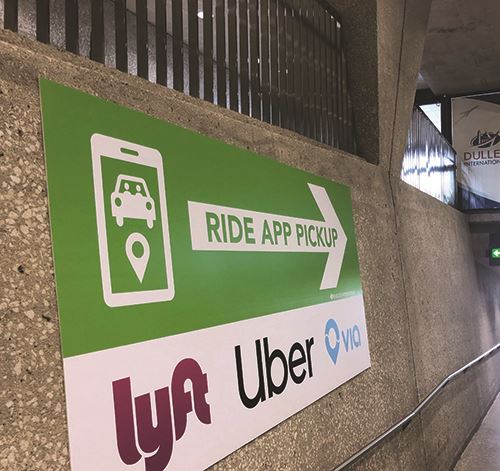Recognizing the need to improve ground transportation flow, the airport operations team zeroed in on traffic from app-based transportation network companies (TNCs) such as Lyft and Uber. In mid-August, IAD debuted what it calls the third curb, an area dedicated solely to TNC pickups. The new system is designed not only to relieve congestion at the curb, but also to make it easier for passengers using app-based ride services to connect with their drivers.
With curbside congestion becoming a growing frustration at Washington Dulles International Airport (IAD), it was clear that something had to change. The influx of vehicles was simply more than the veins and arteries of airport roadways could handle.
 “It was practically gridlock,” relates Vice President and Airport Manager Mike Stewart.
“It was practically gridlock,” relates Vice President and Airport Manager Mike Stewart.
Recognizing the need to improve ground transportation flow, the airport operations team zeroed in on traffic from app-based transportation network companies (TNCs) such as Lyft and Uber. In mid-August, IAD debuted what it calls the third curb, an area dedicated solely to TNC pickups. The new system is designed not only to relieve congestion at the curb, but also to make it easier for passengers using app-based ride services to connect with their drivers.
|
facts&figures Project: New Pickup Curb Location: Washington Dulles Int’l Airport Strategy: Relieve curbside congestion by adding separate pickup area for passengers using Uber, Lyft, etc.
Timeline: Aug. 2019-Aug. 2020 Official Debut: Aug. 18, 2020
Project Design: Johnson, Mirmiran General Contractor: Protec Construction (local disadvantaged business enterprise)
Tolling & Traffic Management:
Vehicle Management Software: Concrete Contractor: JSC Concrete Construction Steel Fabrication: Clark Machine Corp. Steel Erector: LR Wilson & Sons Inc. Solar Panels: Solar Energy Services Inc. Electrical Contractor: Current Alternatives LLC
Quality Control Testing & Inspections: Engineering & Survey Contractor: Bowman Consulting Traffic Maintenance: Top Dog Services Special Inspections & Acceptance Testing: Alpha Corporation; Engineering & Materials Technologies
Pavement Maintenance: |
“We worked closely with the TNCs, looked at real estate we had, and learned lessons from other airports to create a plan,” says Stewart. Portland International and Los Angeles International were among the airports the ops team studied or consulted.
The new TNC pickup spot at IAD is located on the ground level outside of Baggage Claim area just beyond the curb for commercial vehicles. The airport gave up valuable real estate—about 100 spaces in its terminal parking lot—to create the new curb. The bright spot was that COVID-related traffic declines simplified the process of resurfacing and striping the pavement. In the end, IAD was able to capture back some of the parking spots and actually improved the overall flow through the parking lot.
The new TNC curb stretches almost 500 linear feet and includes a steel canopy to protect passengers from inclement weather while they wait. The curb is divided into several zones with alphanumeric labels to help customers find their drivers quickly. (Austin-Bergstrom International Airport in Texas uses a similar zone system.)
Even though recent traffic has been much lighter due to the coronavirus pandemic, IAD personnel can tell that the new curb is helping redistribute vehicle volume. Dividing the various traffic streams helps relieve the pressure of having too many vehicles in one compact area, Stewart explains. Rideshare drivers can now enter and exit more easily because they don’t have to navigate through other pickup traffic.
Additionally, the “third curb” helps facilitate social distancing by separating passengers waiting for TNC rides from other passengers waiting to be picked up by commercial vehicles or family, friends and associates.
Drop-offs from all types of vehicles remain on the main departures level.
Tracking TNC Traffic
When TNC drivers cross one of IAD’s invisible electronic boundaries, their cellphones ping the associated TNC servers. The airport uses GateKeeper software to receive that data, and TransCore oversees the front-end roadway infrastructure—RFID tracking, sensors and vehicle transponders.
“GateKeeper handles all the back-end recording information, and they create the charges and the trips,” explains Forrest Swonsen, associate vice president of Airport Systems and Services for TransCore. “No physical infrastructure is necessary on the roadway; it’s a Google-based geofence that works in the cloud. Essentially, the same feed going back and forth between the driver and the customer is shared with GateKeeper once a TNC vehicle hits the geofence. Then the airport get a slice of that data for tracking.”
 Information IAD receives includes the date, time, coordinates of where a vehicle crosses the geofence perimeter, which TNC is working through, the vehicle license plate number, the driver’s identification code, and the type of trip (e.g. entry, exit, pick-up, drop-off). The airport used the data to track traffic and collect access fees from TNC. Transponder data and spot checks such as random vehicle inspections at the curb, passenger surveys and other automated vehicle monitoring technologies are drastic improvements over the previous honor system used for fee payment.
Information IAD receives includes the date, time, coordinates of where a vehicle crosses the geofence perimeter, which TNC is working through, the vehicle license plate number, the driver’s identification code, and the type of trip (e.g. entry, exit, pick-up, drop-off). The airport used the data to track traffic and collect access fees from TNC. Transponder data and spot checks such as random vehicle inspections at the curb, passenger surveys and other automated vehicle monitoring technologies are drastic improvements over the previous honor system used for fee payment.
The airport project team spoke directly with app-based rideshare companies and individual drivers to ensure that the new process would work well. “The biggest concern from drivers was that they didn’t want to be stuck in a remote area that would not be convenient for passengers,” says Stewart.
Don Griffin, senior manager of Airport Business Development for Lyft, notes that IAD’s new pick-up area is conveniently located outside of baggage claim at ground level. “By having a dedicated rideshare curb that is still within close proximity, Lyft riders can receive prompt and improved service without having to walk a great distance,” says Griffin.
Several TNCs collaborated with the airport to make sure the new system would improve efficiency at the curb and accommodate rider preferences.
 Griffin and his staff met regularly with the IAD team early in the design process. “Our discussions included recommendations on a multitude of operational aspects, including layout for passengers and vehicles, vehicle throughput, signage, activation date and other rideshare considerations,” says Griffin.
Griffin and his staff met regularly with the IAD team early in the design process. “Our discussions included recommendations on a multitude of operational aspects, including layout for passengers and vehicles, vehicle throughput, signage, activation date and other rideshare considerations,” says Griffin.
The airport also asked passengers what was important to them, and used their input to improve the pickup process and area. Signage was refined from April to August, during COVID downtime.
Quick Turnaround
Vik Singh, vice president of Protec Construction, recalls the airport approaching his company in August 2019, two weeks before the curb and canopy project was bid. “We won the job on technical excellence and got started three weeks from that day,” he remarks.
Before construction began, the contractor encountered pre-existing soil conditions, duct banks and abandoned concrete piers that had to be demolished. “You can’t predict these things,” says Singh. “We prepare for those kinds of unknowns.”
The project was also challenging because the worksite was located in the busy front section of the airport. Crews had to block off the main parking lot and a full commercial bus lane to receive and stage construction materials. To avoid the heaviest traffic, most work was performed at night. Outages and switchovers had to be carefully coordinated with the airport operations and parking teams.
“Each time it rained, we had to stabilize the ground and test it multiple times,” adds Singh. “When it rains, concrete loses compaction, so we had to add sub-base. It was a challenge to do that during the winter months.”
The project team paused construction for the holidays and severe weather. Fortunately, construction was largely finished by the time the coronavirus lockdown began in March. All that remained were minor touchups, electrical tie-ins and final run-throughs.

Crews Worked West to East
Protec demolished the existing curb and sidewalk, excavated for footings and began construction by pouring the new footings. It then managed the subsequent installation of the structural steel frames, steel decking, electrical rough-ins and solar panels.
Originally, the project had three phases, but Protec divided work into two geographic sections. “It made the most sense to start on the west end, with the demolition, concrete pouring, adding the canopy posts, painting and sidewalks. Then we tackled the east canopy side,” Singh relates. “It was easier to start with west entrance because of the way we could receive the structural steel members, concrete trucks, boom trucks and cranes in and out.”
The revised two-phase approach also worked better because vehicle traffic flows from west to east.
After both sides of the canopy were complete, the Protec team used existing underground tunnels to connect the electrical cabling through the duct bank. At the same time, crews installed the solar panels on the roof, taking care to slope them so they don’t accumulate snow and rain.
 “We wanted the solar panels on top of the angled metal roof to take as much sun as possible,” Singh explains. “The panels charge up all day to collect and store energy. The airport is not using any other power for lighting [in the TNC pickup area].”
“We wanted the solar panels on top of the angled metal roof to take as much sun as possible,” Singh explains. “The panels charge up all day to collect and store energy. The airport is not using any other power for lighting [in the TNC pickup area].”
There is ample room for additional solar panels to generate even more power to use in the terminal, he notes.
The trusses, frames and canopy tops are made of hot dip galvanized steel. As required by the Metropolitan Washington Airports Authority, they were fabricated and erected by contractors certified by the American Institute of Steel Construction.
Singh estimates that the steelwork process took about three months, including fabrication, galvanizing (in Pennsylvania), shop priming and inspection/testing. “It’s very well built,” he says. “If it is maintained properly, it’s going to last a lifetime.”
Singh credits an engineering and facility services department at the Airports Authority for playing a significant role in the project. He says that without its coordination, communication and dedication, Protec would not have been able to meet the stipulated deadlines.

Data Loss Was Unacceptable
Swonsen emphasizes the need to prevent or minimize the loss of data when adding a new feature such as TNC-only curb. That’s why he advocates using a test bed.
Even though IAD has been using RFID to track commercial vehicles since 2007, making physical and business changes without impacting traffic flow was still challenging.
“Operations like this can’t afford to lose revenue or data,” says Swonsen. “When you add TNC operations, you have to be able to update the back-end software without interrupting data flow or revenue. The airport relies on that information from a planning standpoint. Data aggregation is the new big thing, and getting that in one dashboard is a big help because it provides a clearer picture of curbside utilization.”
TNC data is uploaded to a cloud-based platform, and data is pulled and leveraged with information about taxi dispatches and other commercial vehicle activity to drive reporting information for an integrated perspective. Creating an aggregated picture is really valuable, stresses Swonsen.
“What we’re working on now is syncing up the back end to close the trips on the third curb,” he says. “That, in turn, can generate dwell time information and other data the airport will use.”
Although the new curb was ready for traffic in April, Stewart and his team decided to delay its official debut until August because there was no immediate need for it during the COVID-19 shutdown. But as traffic inches back up, they are noticing the arrivals curb getting crowded again.
“All we have heard from the drivers has been positive,” he reports. “When we get busy again, they won’t have to weave through what could be gridlock.”



